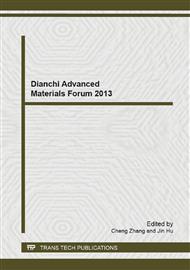p.29
p.33
p.37
p.41
p.45
p.50
p.56
p.61
p.66
Sol-Gel Synthesis of Nanocomposite Li4Ti5O12/Carbon Nanotubes as Anode Materials for High-Rate Performance Lithium Ion Batteries
Abstract:
Abstract. Nanocomposite Li4Ti5O12/carbon nanotubes (Li4Ti5O12/CNTs) are facilely synthesized by a sol-gel method. The crystal structure and morphology of the nanocomposite Li4Ti5O12/CNTs are characterized by X-ray diffraction (XRD) and scanning electron microscopy (SEM), respectively. CNTs play the important role just like a big network connecting the nanoparticles of Li4Ti5O12, which provides a good channel for electronic conductivity and ion transport. Within the cut-off voltage between 1-2.4V, the initial discharge capacity of Li4Ti5O12/CNTs material is 179.6 mAh/g at the rate of 0.1C. The capacity retentions are 95.5% and 90.6% of Li4Ti5O12 with and without CNTs, respectively. At high current density of 10C, Li4Ti5O12/CNTs delivers the initial capacity of 141.5 mAh/g, and without any capacity loss after charge/discharge 100 cycles. The matrix of CNTs plays important roles in increasing the conductivity and avoiding the aggregation of Li4Ti5O12, which lead to high-rate capacity and cycling performance.
Info:
Periodical:
Pages:
45-49
Citation:
Online since:
November 2013
Authors:
Price:
Сopyright:
© 2014 Trans Tech Publications Ltd. All Rights Reserved
Share:
Citation:


